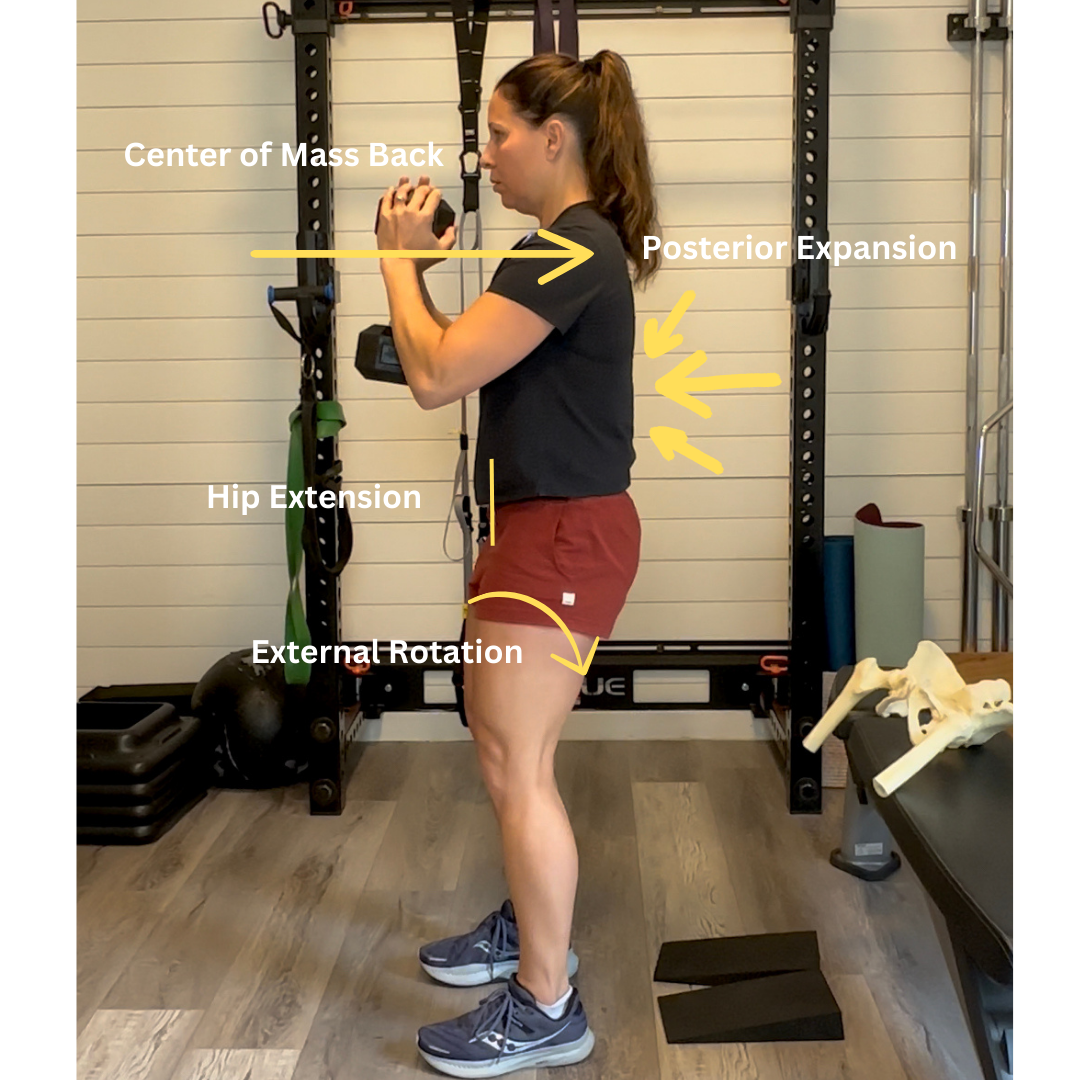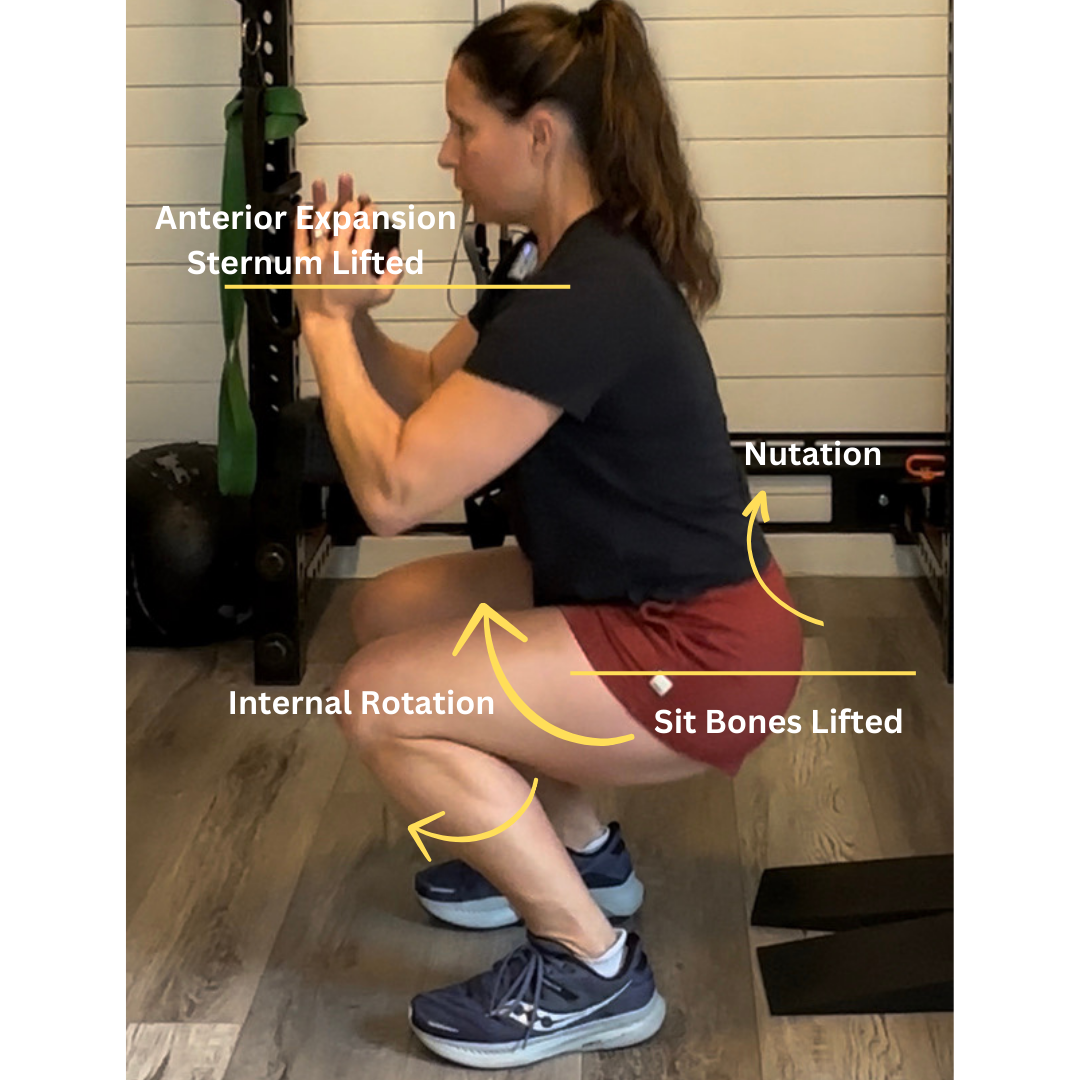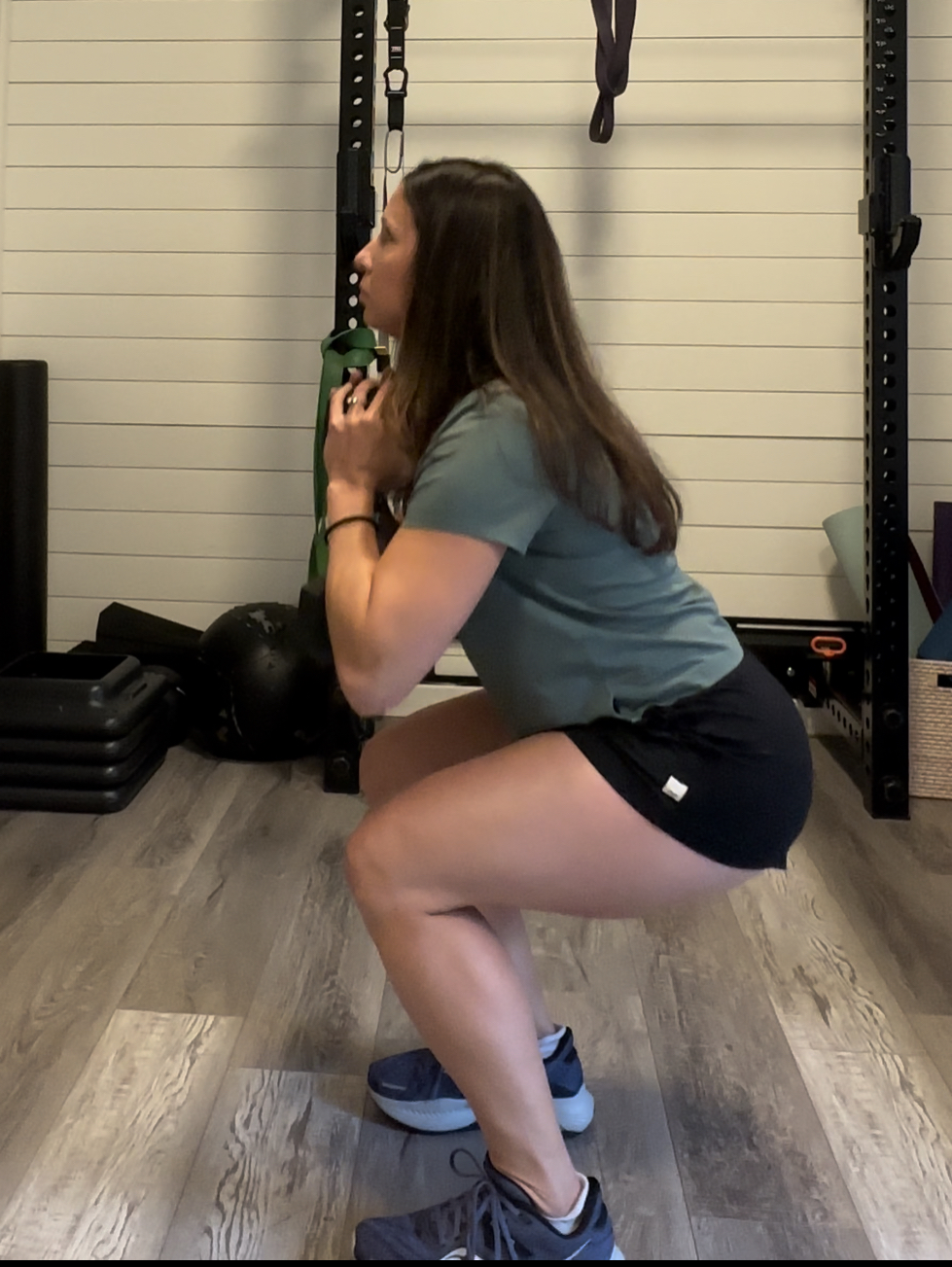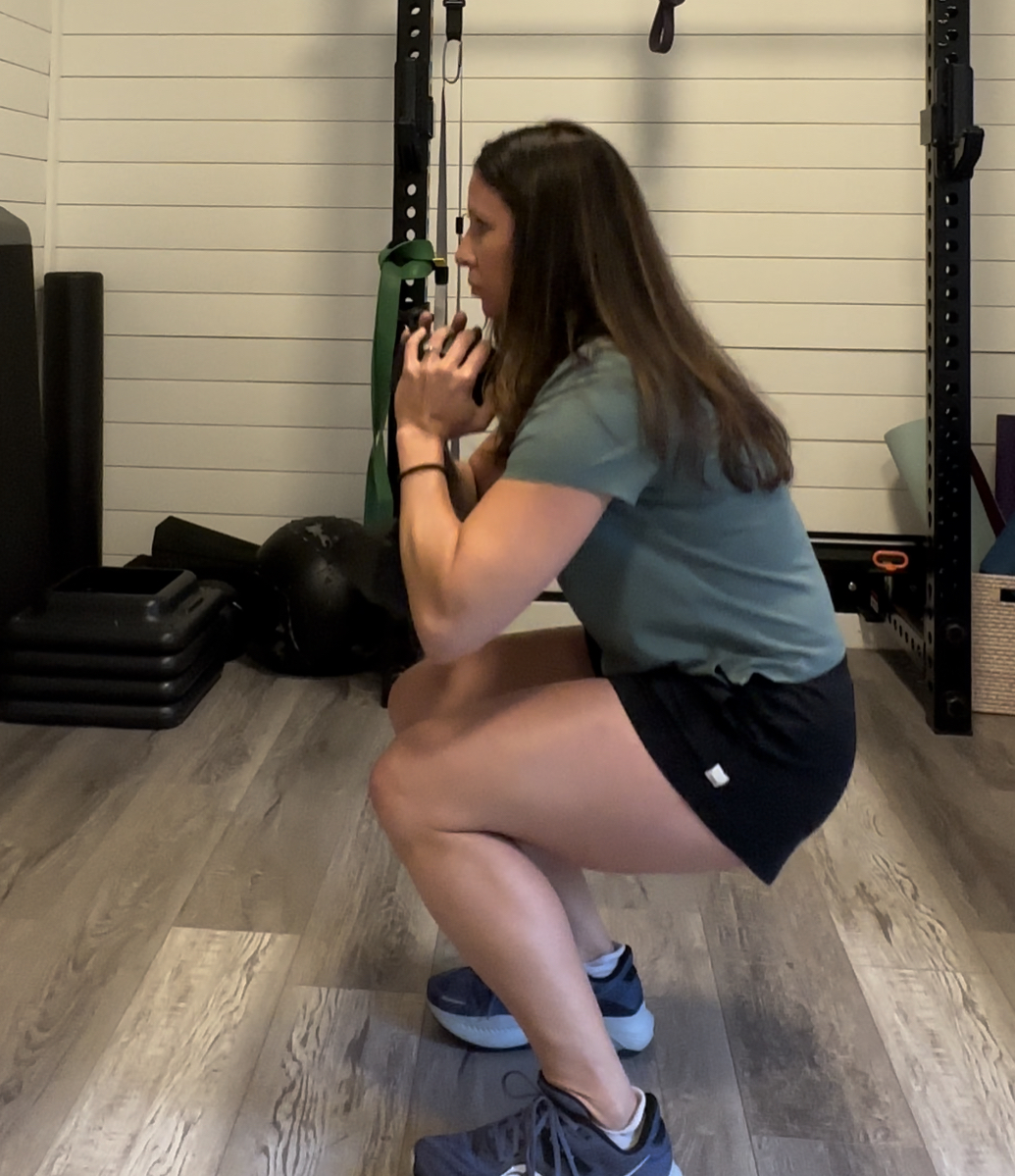Leaning Forward, Over-Tucking, and Butt Winking in a Squat
Oct 16, 2023When it comes to squats there are a ton of possibilities for how we preform them and if you have been in the industry for a long enough time you have probably cued them differently over the years. I know I have!
I've coached the good ole fashioned "sit your hips back and do not let your knees go over your toes" and the wonderful, "spread your feet wide and push your knees out", and the ever popular "put a band around your knees to really activate the glutes."
One thing I've never done is have someone squat on a stability ball. A bosu, yes, but a stability ball, never. There's alway 2030? 😅

I truly don't think there is a wrong way to preform a squat. Well maybe the example above is not the best, but if you are standing on the ground squatting then I think its okay to mix it up and try different things. But I do think that if someone is experiencing irritations like low back pain, SI pain, knee pain, etc, then it might be helpful to understand what is happening, especially in terms of relative motion at the pelvis and femurs as we go into different ranges of hip flexion in the squat and how we may compensate if we are lacking the requisite motion.
Here is a brief overview of the relative motion needed for a more vertical squat that goes all the way down, as they like to say (Ass to Grass).
*Check out the video for more details
At the top of the squat we need to be able to extend the hips to stand upright, and there is more relative external rotation at the femurs and the pelvis with a sacrum that is more counter-nutated. We need to have a thorax that can shift back in space so that we don't hinge forward too much as we descend down.

As we get closer to the mid range of the squat (around 60-100 degrees) we start driving more internal rotation and adduction of the femurs, which causes a relative opening of the posterior outlet, creating more internal rotation of the ilium and relative nutation of the sacrum. We need both anterior expansion of the chest wall and posterior expansion of the thorax. In addition the knees need to be able to go over the toes which requires dorsiflexion, internal rotation of the tibia and pronation of the foot. (I'll come back to this mid range portion when I explain the compensations and how lack of motion here might create a problem.)

As we go into the deeper ranges of the squat (>100-120 degrees, depending on the person) the entire pelvis needs to posteriorly orient back underneath us, we need even more posterior expansion of the thorax and the femurs and the pelvis relatively externally rotate and the sacrum counternutates, the knee maximally flexes and the shin angle decreases. There is now max pressure pushing down into the pelvic floor.

1. Let's start with the ever common leaning forward or "hingey" squat.

**Let me start by saying there is absolutely nothing wrong with this squat variation, unless you are experiencing consequences because of the lack of relative motion or you would like to be able to get down lower in a squat.
Common complaints I may hear:
- I've got pinching in the front of the hip.
- There is a lot of tension in my low back and hip flexors.
- I just wish I could squat deeper.
So why would someone squat this way, aside from being cued to squat this way?
If someone is in a more extended posture to start and is lacking the requisite posterior expansion of the thorax and the ability to maintain the pelvis in a more "neutral" starting position, then the pressure will push the viscera forwards towards the abdominal wall. When this happens the natural course of action is to allow the pelvis to move more horizontal and less vertical but the squat will be limited by the available hip flexion. In essence we are already starting in more hip flexion and lumbar extension so we don't have as much left to go, and because we don't have posterior expansion of the thorax it is harder to maintain an upright "stacked" position.
2. Over-tucking is another compensation we may see, although I tend to see it less than the hingey squat.

** I will note that sometimes this can be subtle and not as pronounced as you see in this picture but just a lumbar spine that stays in a relatively flexed position and a sacrum that stays in more counternutation throughout the entire range.
Common complaints I may hear:
- This hurts my back and / or SI joint area.
- This is making my pelvic floor symptoms worse.
- This hurts my knees.
- I don't feel my glutes or hamstrings working at all.
So why would someone squat this way?
If someone has a lot of compression in the chest wall, is in a more kyphotic posture or more sway backed then they will lack the ability to keep the sternum lifted and they will be more likely to tuck the tail.
**To experience this in your own body just try sitting or standing up straight and notice what happens at the pelvis vs. slouching.
When someone begins to squat down in this position they will get to mid range and lack the ability of the posterior pelvis to open and go into internal rotation along with lengthening in the back of the hip to allow for internal rotation of the femurs. The posterior pelvic floor can't lengthen so the only other options is to tuck under excessively and lose the natural lordotic curve of the spine and bypass the mid range mechanics. This puts a lot of pressure on the lumbar spine in flexion which is fine at lighter loads but may have consequences at heavier loads. This also puts a lot of pressure down into the front of the pelvic floor. In addition, this does not allow the femurs to glide back into the socket and internally rotate which can cause irritation at the knee joint. This position is also going to make it hard to lengthen and load the hamstrings and glutes so the sensation and activation of those muscles is reduced.
3. The all too common compensation, the butt wink, is likely a combination of the first 2.
Usually people can squat down to the mid range, whether it be more rounded or more hinged forward, but when they start in the more hingey position and hit their end range and run out of the requisite internal rotation required they can then keep going by creating a quick flexion moment at the lumbar spine, this is the "wink". For some people this has no consequences but for others this quick flexion can really create a lot of irritation, usually around L4-S1. I have found that stopping them above that point while working to restore better position to achieve a smoother transition to be extremely helpful.
I can just hear the questions at this point...
So how do you get there? How do you optimize these three ranges to be able to squat without compensation? Is it safe to continue to squat more hingey or more flexed or with a butt wink?
I'll start by saying that if you don't have any irritations, your body feels good squatting however you squat and you aren't really concerned with limitations in movement (relative motion at the hips, shoulders, etc.) then you don't need to worry about it and this post is probably not for you. ☺️
If you do struggle with mobility and always feel some sort of niggle or irritation, then working on this stacked position in a squat can be a game changer for restoring range of motion throughout the body, while still training!
If this is you then keep reading!
Step 1: Optimizing hip extension and posterior expansion of the thorax.
Mobility Drill: Elevated Nordic Wall Plank
I love this drill because it gives us a ton of bang for our buck and it is actually training our muscles so its a great warm up exercise. We get hamstrings and abs on board to help pull the pelvis underneath us and create some hip extension and the position of the arms allow for the shoulder blades to move out of the way so we can create expansion into the posterior thorax.
Squat Drill: Upper 1/3 Respiratory Squat
This variation is helping us push our center of mass back with the help of the wedges and the counterweight so we can maintain that upright position, it will also help us feel where we naturally start going into a more internally rotated and nutated position.
*Wedges are optional depending on your bodies dimensions and current ability to stay upright.
Step 2: Optimizing internal rotation and posterior expansion of the pelvis.
Mobility Drill: Bear Plank to Modified Down Dog
This is another great drill to add to a warm up because it has a ton of benefits and is great for driving internal rotation. As we push away from the floor we get serratus on board to help pull the scaps onto the rib cage and by keeping the sternum lifted we can get chest wall expansion. The sit bones stay lifted to allow for posterior expansion of the pelvis and length between the sit bones and in the back of the hips. The modified down dog targets that lower range of the mid range to allow for even more posterior pelvic floor expansion and a deeper range of hip flexion.
Squat Drill: Mid Range Adduction Respiratory Squat
This variation is great if you feel confident about the stack in the upper 1/3 squat and can maintain a relatively upright position, while still keeping the sit bones lifted and sternum from dropping. It is also great to help you feel the transition between the upper to mid range and make sure you are not overtucking or going into more of a hinge or excessive arch.
Step 3: Optimizing posterior expansion of the thorax and posterior orientation of the pelvis.
Mobility Drill: Rock and Roll to Low Squat or Low Sit
This is a favorite drill of mine because it is fun to roll around and it can feel like a massage for the back and the spine. The goal is to really expand through the back so we can get into those deeper ranges. If you can't sit into the low squat, do not worry, just start with the low sit.
Squat Drill: Low to Mid Range Respiratory Squat
Finally, the lower ranges of the squat! While there can be benefits to the deeper ranges, in most cases it is not necessary for people to go all the way ATG, so if you aren't looking to squat with load at this range, just holding and breathing in this position with light weights or using the rock and roll drill can be enough to gain. you some expansion and improve external rotation and lumbar flexion. But if you do decide you want to go there, practicing the transition from low to mid can be super helpful.
3 Stop Respiratory Squat Challenge
These drills can be a great way to improve mobility so that you can squat all the way down with less compensation BUT if you have the capability to squat all the way down then performing a 3 Stop Respiratory Squat can be a great warmup activity to restore range of motion throughout the entire body.
If you are ready to give it a try, click HERE.
If you are not quite there then I recommend working through the other ranges first. Shoot for doing the mobility drill and the squat drill a couple of times a week for 2-3 sets in your warm up or in between sets of your main lifts or as accessory exercises. As you progress you can move into deeper ranges until you can reach your full squat depth.
If you found this useful and are looking to learn to go a bit deeper into these concepts and have a guided daily practice to start to improve range of motion at the shoulders and hips with an inside out approach then make sure and check out my courses Scapulothroacic and Lumbopelvic Foundations. They both contain over 60 exercises, tons of learning content and are self paced with lifetime access. Use the code 15OFFFOUNDATIONS for 15% off. (this includes the bundle option)

